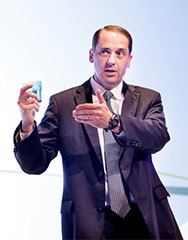We need choice in the food chain
 Jeff Simmons, president of Elanco Animal Health, was on hand at the Northeast Dairy Producers Association annual meeting in Liverpool, N.Y., to discuss, "Choice in the food chain and dairy's opportunity in feeding the world. Simmons' presentation had three key components involving: technology, choice, and leadership.
Jeff Simmons, president of Elanco Animal Health, was on hand at the Northeast Dairy Producers Association annual meeting in Liverpool, N.Y., to discuss, "Choice in the food chain and dairy's opportunity in feeding the world. Simmons' presentation had three key components involving: technology, choice, and leadership.Citing United Nations data, Simmons noted, 50-100-70 would be the key numbers driving food production. "Specifically, in the next 50 years the world will need 100 percent more food, and 70 percent of that additional food will come from improved technology," said Simmons, noting there was little arable land not already in agricultural production.
Countries like China and India, with one-third of the world's population, want to grow more food for their citizens. At the same time, they want to devote less of each citizen’s personal income to food. "India spends 50 percent of personal income on food," said Simmons. "That compares to 26 percent in Japan, 22 percent in the United Kingdom, and 10 percent in the U.S. Technology can lower food costs," he went on to say. "Look at the U.S., for example. In 1908, the American consumer spent 50 percent of personal income on food. Today, he or she spends only 10 percent."
The second key component is choice. Simmons pointed out that Elanco reviewed consumer surveys conducted in the past two years that asked unaided questions to consumers which means that questions were not of a leading nature. After that review, they found that 95 percent of consumers are really looking at: availability, affordability, and nutrition when buying food.
"That means only 5 percent of consumers purchased food on luxury choices and personal wants such as organic or vegan lifestyles," Simmons stated. "This finding is holding true today," Simmons pointed out. "The recession has put some economic logic back into the system."
Lastly, and perhaps most importantly, Simmons pointed out dairy producers need to share this message with others and provide leadership on food. "We don't all have to agree on every issue," he said. "However, we need to align ourselves and move in the same direction," he said when talking about moving agriculture and food-related issues forward. "If we wait for total agreement, we will never move forward," he told the 550 people attending the Northeast Dairy Producers Association meeting just outside Syracuse, N.Y.
Labels: food production, food security, NEDPA